There are 24 different types of turtles in Louisiana as well as 5 species of sea turtles that can be seen off the coastal water.
These range from Box turtles, Cooters, Snapping turtles, Diamondback Terrapins as well as an endangered tortoise. Louisiana, though typically shown as nothing but swampland, actually has a wide variety of landscapes. That’s why you can find such a wide range of reptiles.
Keep reading as we go over all the native turtles found in and around Louisiana.
Table of Contents
Box Turtles in Louisiana
1. Eastern Box Turtle

- Experience Level: Beginner
- Family: Emydidae
- Scientific Name: Terrapene carolina carolina
- Other Names: Land Turtle
- Adult Size: 4 to 7 inches
- Life Span: 50 to 100 years
- Average Price Range: $260 – $360
- Conservation Status: Michigan, New Hampshire, Massachusetts, and Connecticut—list the animal as a species of special concern, and Maine lists the turtle as endangered.
The Eastern Box turtle lives among forest floors and other areas with plenty of damp soil. They are terrestrial turtles that don’t spend much time at all in the water.
These turtles can swim, but prefer to roam the earth. These turtles have a high domed shell that they can close themselves into when threatened.
The carapace (upper shell) is olive, dark brown, or black with yellow to reddish ornate markings that resemble paint runs. The same coloration continues on their heads and limbs.
Eastern Box turtles enjoy a wide range of foods. They will eat fungi, berries, grasses, insects, worms, spiders, slugs, and snails, as well as some carrion.
2. Ornate Box Turtle

- Experience Level: Intermediate to Expert
- Family: Emydidae
- Scientific Name: Terrapine ornata
- Other Names: Box Tortoise, Western Box Turtle
- Adult Size: 4 to 5 inches
- Life Span: 30 to 40 years
- Average Price Range: $150 to $450
- Conservation Status: Near threatened
Similar to the Eastern Box Turtle, these colorful turtles have distinctive patterning on their shells, sporting a series of yellow to orange stripes. Their bodies have light colored speckles on their skin. Ornate Box Turtles are classified as threatened in Louisiana, and near threatened elsewhere.
Their preferred habitats are open, grassy areas, as they can handle dryer air compared to other box turtles.
In the winter, Ornate Box turtles will either dig out a burrow or take over an abandoned one. There they hibernate until the temperatures warm up and they emerge.
Ornate Box turtles roam freely across the land but will return every year to their original nesting site.
These turtles are omnivorous and will eat insects, vegetation, berries, flowers, and occasional rotting carcasses. Though they don’t touch carrion in advanced decay.
3. Three-toed Box Turtle
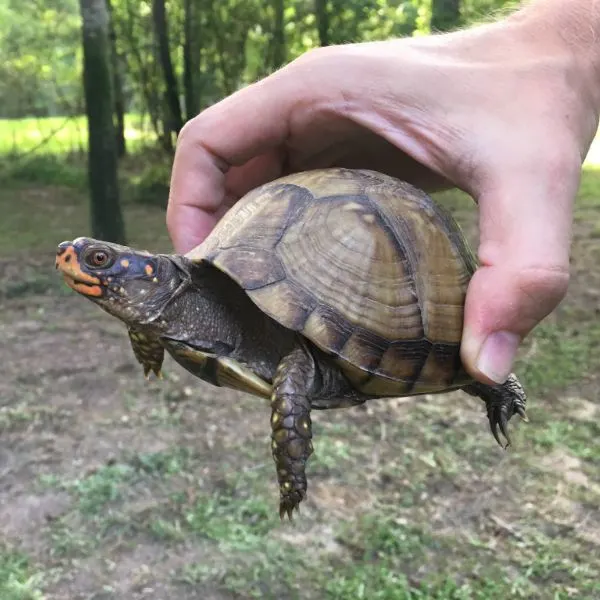
- Experience level: Intermediate
- Family: Emydidae
- Scientific Name: Terrapene carolina triunguis
- Other Names: N/A
- Average Adult Size: 4.5 – 6.5 inches
- Life Span: 70+ years
- Average Price Range: $140 – $430
- Conservation Status: Vulnerable
The Three Toed Box turtle is the least decorated of North American Box turtles. They still have a hinged plastron (lower shell) and can withdraw completely for protection, but they are usually a drab brown color.
As their name suggests, they have three toes on their hind legs. With that being said, there are some Three Toed Box turtles that have to be different and sport four toes on their hind legs.
When there isn’t sufficient moisture to keep these turtles hydrated, they will dig a burrow to reach humid soil. They range through grasslands and prairies that don’t always have access to water.
Three Toed Box turtles sometimes mate with other Box turtle species when they meet, often creating hybrids.
It’s thought that these turtles can consume poisonous mushrooms and toadstools, which then causes them to become mildly toxic. There was a report of a few people eating a Three Toed Box turtle, then subsequently becoming sick.
Not only do they eat mushrooms but they will also eat cacti, fruits, insects, worms, and anything else edible.
Chicken Turtles in Louisiana
4. Eastern Chicken Turtle

- Experience level: Beginner
- Family: Emydidae
- Scientific Name: Deirochelys reticularia
- Other Names: N/A
- Average Adult Size: 6 – 9 inches
- Life Span: 13 – 20 years
- Average Price Range: $150 – $300
- Conservation Status: Threatened
The Chicken Turtle doesn’t sport feathers, cluck, or eat chickens, instead, they get their name because reportedly they taste like the egg-laying yard bird.
These turtles have a long neck and netted patterns on their carapace. The shell also has a wrinkled appearance, and the plastron (lower part of the shell) is yellowish or tan. On their head and limbs, you’ll see wide yellow to white stripes.
Chicken turtles are equally at home on land and in the water. They prefer still, to very slow moving, shallow waters such as swamps, bogs, and small ponds. They won’t share a habitat with large predatory fish or alligators.
These turtles are mostly carnivorous, feeding on tadpoles, fish, crayfish, dragonflies, spiders, and other aquatic insects. They use their long necks to hunt and catch swift moving prey.
Cooters in Louisiana
5. Eastern River Cooter
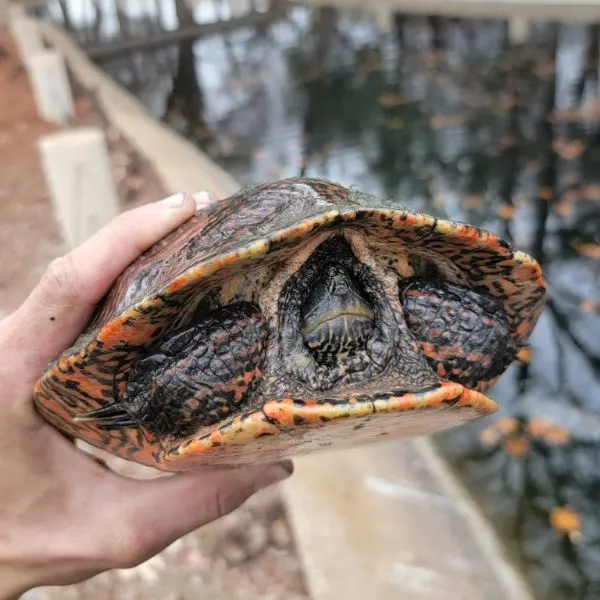
- Experience Level: Beginner to Intermediate
- Family: Emydidae
- Scientific Name: Pseudemys concinna concinna
- Other Names: River Cooter
- Adult Size: Between 8 and 12 inches
- Life Span: Between 20 and 40 years
- Average Price Range: $20 to $50
- Conservation Status: Special concern
The Eastern River Cooter is a colorful medium to large turtle. Their shells are highly patterned and they have dark skin with yellow, cream, or white stripes. Juveniles are much more colorful as the adult colorations fade and darken with age.
The plastron on the Eastern River Cooter is pale tan or yellowish and can have a midline pattern. As their name suggests, rivers are their preferred habitat, but they can sometimes be found in ponds, lakes, and streams.
When looking for a place to stay, River Cooters look for plenty of basking spots as this is a beloved pastime. They also need plenty of aquatic vegetation as they are mostly herbivorous.
Juveniles feed more on insects, small fish, and mollusks as they need the protein to grow faster.
Terrapins in Louisiana
6. Mississippi Diamondback Terrapin

- Experience level: Intermediate to Expert
- Family: Emydidae
- Scientific Name: Malaclemys terrapin pileata
- Other Names: Mississippi Diamondback Terrapin, Diamondback Terrapin
- Average Adult Size: 5.5 – 8 inches
- Life Span: 25 – 40 years
- Average Price Range: $300 to $1,000 It’s illegal to own Diamondback terrapins in some states, while you need a special permit to own them in other states, including Alabama.
- Conservation Status: Endangered
The Mississippi Diamondback Terrapin is an aquatic species that favors brackish waters along southern coasts. They can inhabit tidal marshes, and estuaries but they rarely spend time in full-strength saltwater.
Diamondback Terrapins are small turtles that have a distinct diamond shape to their carapace. These turtles are very popular among turtle owners because they are so strikingly beautiful.
Their shells range from brown to grey, and their skin can be grey, brown, white, or yellow, but all of them have highly contrasting stripes, spots, or squiggles.
To get fresh drinking water, the Diamondback Terrapin will either swim to the surface and drink the rainwater that congregates there before it mixes, or they will come ashore and hold their mouths open.
Females are nearly twice as big as males, and they have larger, stronger jaws that allow them to eat clams, mussels, and other hard-shelled sea creatures.
Map Turtles in Louisiana
7. False Map Turtle
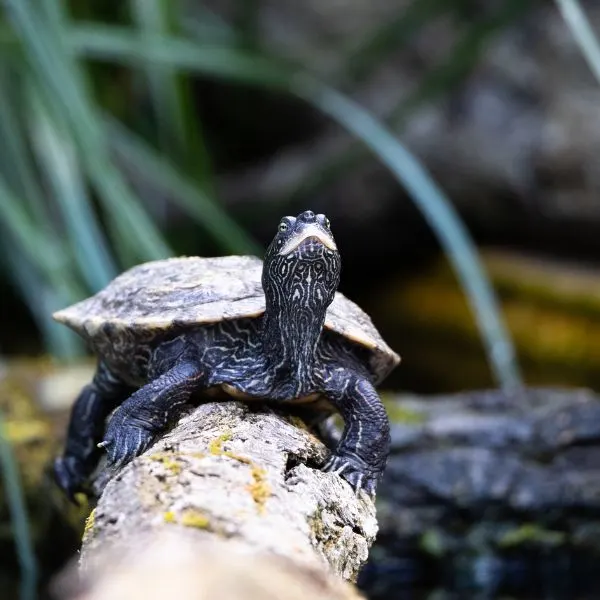
- Experience Level: Beginner
- Family: Emydidae
- Scientific Name: Graptemys pseudogeographica
- Other Names: Sawback turtle
- Adult Size: 3.5 to 10.5 inches (9 to 26.5 cm)
- Life Span: 30 to 50 years
- Average Price Range: $6 to $40
- Conservation Status: Least concern
False Map turtles and other species of map turtles have light colored swirls and stripes that resemble map markings, hence their name. The carapace background is usually brown, grey, or olive colored.
Map turtles have a pronounced keel running along their backs that tends to smooth out some as they age. Most have a serrated back end of the shell, which lends to the nickname Sawback turtle.
Map turtles prefer large rivers with abundant basking spots. Though these turtles are very skittish, you may see them sharing basking sites with other species.
Their diet often consists of freshwater mussels, clams, and the introduced Asiatic clam. False Map turtles like to overturn rocks and pebbles in the rivers to stir up insects and eat them.
8. Northern Map Turtle
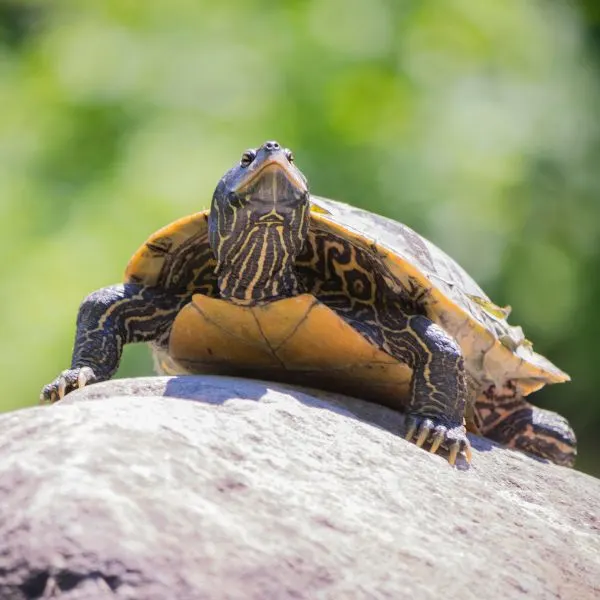
- Experience Level: Beginner
- Family: Emydidae
- Scientific Name: Graptemys geographica
- Other Name: Common map turtle
- Adult Size: Between 4 and 10 ½ inches
- Life Span: 15 to 20 years
- Average price range: Between $20 and $60
- Conservation Status: Least concern
These beautiful turtles are named for their markings. s have dark brown or olive green shells and yellow patterns that resemble the contours of a map. At first glance, you may think this is a Painted turtle.
Small yellow spots behind the eyes separate the Northern Map turtle from other species. Though not very reliable, the Northern Map tends to get bigger than many other Map turtle species.
Large bodies of water such as rivers and lakes with abundant basking spots are where you will find these turtles. Though you may never see them because they are reclusive and will drop into the water when disturbed. They can also stay underwater for a long time.
Mussels, clams, and other bi-valves as well as crayfish and snails make up most of this turtle’s diet. Females are able to handle larger prey as they are bigger and have stronger jaws.
9. Ouachita Map Turtle

- Experience Level: Beginner
- Family: Emydidae
- Scientific Name: Graptemys ouachitensis
- Other Names: Southern Map turtle
- Adult Size: 3.5 to 10 inches (9 to 25.5 cm)
- Life Span: 15 to 20 years
- Average Price Range: $40 to $100
- Conservation Status: Least concern
To tell a Ouachita Map turtle from other Map turtles, look for large yellow or white spots on the side of their heads. Just like other subspecies, their carapace is usually olive green with contoured markings and a prominent keel.
Their eyes are bright light blue to white with a dark line running horizontally across.
Instead of fast flowing rivers, the Ouachita turtle prefers slow, or stagnant waters. Marshlands, swamps, and ponds are their favorite, but when these aren’t available they will withstand smaller rivers and streams.
The Ouachita Map turtle is omnivorous and will eat a wide variety of fruits, berries, plants, insects, and fish.
10. Pearl River Map Turtle

- Experience Level: Intermediate
- Family: Emydidae
- Scientific Name: Graptemys Pearlensis
- Other Names: N/A
- Adult Size: 3 to 5 inches (Males) and 8 to 10 inches (Females)
- Lifespan: Up to 30 years
- Average price range: Between $200 and $500
- Conservation Status: Endangered
The Pearl River Map turtle is a rare subspecies of Map turtle, seen only in Louisiana and Mississippi. The Pearl and Bogue Chitto Rivers are the only two places this turtle is found.
Their numbers were limited when it was discovered, and even now not much is known about this species. Pollution and a decline in native river mollusks threaten the remaining Pearl River Map turtles.
Their shells are green to olive with yellow and black markings. This species of Map turtle has a black line on the carapace that runs unbroken from front to back. The upper half of this turtle’s head is covered in white, and the rest of the skin is green with white stripes.
Though omnivorous, these turtles prefer to eat mollusks, clams, and mussels, while smaller males feed mostly on insects and smaller mollusks. They will also eat some vegetation.
11. Ringed Map Turtle
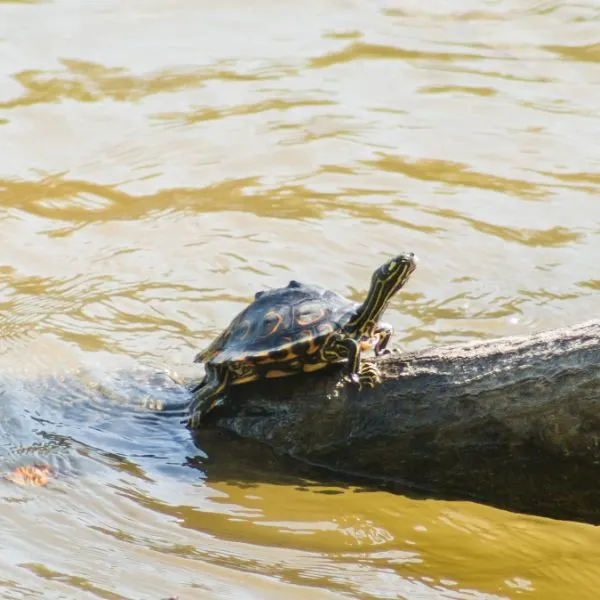
- Experience Level: Intermediate
- Family: Emydidae
- Scientific Name: Graptemys oculifera
- Other Names: N/A
- Adult Size: 4 to 7 inches
- Lifespan: Between 30 and 50 years
- Average price range: Between $700 and $1000
- Conservation Status: Threatened
Ringed Map turtles are easy to identify among other Map turtles species because of the distinct rings on the carapace. They also have 3 to 4 saw-toothed projections sticking up from their carapace.
A federally threatened species of turtle, the Ringed Map turtle is illegal to keep as a pet in many states, including Louisiana.
The plastron of these turtles is yellow. The skin along the limbs, head, and neck is usually dark brown to black with yellow stripes. There is a yellow stripe that runs from the snout on either side to behind both eyes.
Ringed Map turtles are mainly confined to a couple of eastern counties near the Pearl River along the same areas as the Pearl River Map turtle. This subspecies of Map turtle is mostly carnivorous; they feed on mollusks, clams, and insects.
12. Sabine Map Turtle

- Experience Level: Beginner
- Family: Emydidae
- Scientific Name: Graptemys sabinensis
- Other Names: N/A
- Adult Size: 5 inches to 10 inches
- Lifespan: Between 30 and 50 years
- Average price range: Between $30 and $70
- Conservation Status: Not listed
Sabine Map turtles are another subspecies of Map turtles only found in small areas. These turtles tend to inhabit the Sabine river and tributaries along the Louisiana and Texas border.
They prefer faster moving waters with plenty of aquatic vegetation and muddy, sandy, or rocky bottoms. They will bask on rocks, logs, or other sites with other species of turtles.
These turtles have a small head with a yellow or orange dot behind each eye. The rest of the body has yellow or reddish colored stripes.
The carapace is similar to other map turtles with swirls and markings, as well as the centerline keel and saw-backed scutes at the rear.
Sabine Map turtles are omnivores. They will eat algae, insects, clams, crayfish, and more, but it appears that caddisfly larvae are a favorite among these turtles.
Mud Turtles in Louisiana
13. Eastern Mud Turtle

- Experience Level: Beginner
- Family: Kinosternidae
- Scientific Name: Kinosternon subrubrum
- Other Names: Common mud turtle
- Adult Size: 3 to 4 inches
- Life Span: 40 to 50 years
- Average Price Range: $20 – $100
- Conservation Status: Least concern
Frequently referred to as the Common Mud Turtle, these turtles have a highly domed carapace with no ridges or patterns. The most common color is brown, but they can be olive or black. Limbs are solid colored, while the head tends to have lighter colored stripes.
The plastron is solid colored and is double hinged like a box turtle. When threatened, the Eastern Mud turtle will pull itself into the shell, but it may also bite, for these turtles are aggressive.
While not great swimmers, these turtles prefer slower moving waterways with plenty of vegetation. They can climb though and will use the vegetation to get to the surface for air, and even climb trees.
When tree branches hang low, or reach into the water, Mud turtles will climb up them and search for food in trees. So watch out for falling turtles when visiting the Louisiana bayous.
When hibernating, the Mud turtle will dig into the soft ground and bury itself until spring. They don’t travel far from water because they are slow moving and prefer the safety of their pond.
Eastern Mud turtles are omnivorous, though they eat meat more than vegetation.
Musk Turtles in Louisiana
14. Eastern Musk Turtle
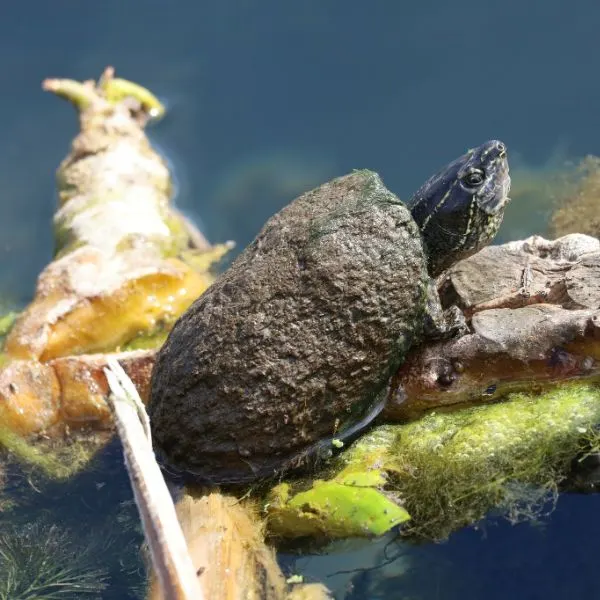
- Experience Level: Intermediate
- Family: Kinosternidae
- Scientific Name: Sternotherus odoratus
- Other Names: Common Musk turtle, Stinkpot
- Adult Size: 4 to 5 inches (10 to 12.5 cm)
- Life Span: 30 to 50 years
- Average Price Range: $30 to $120
- Conservation Status: Least concern
Affectionately called “Stinkpots” by owners, they can release a malodorous stench from their musk glands. While some people don’t mind this, most predators find they can’t stomach the stink and find more pleasing things to eat.
Eastern Musk turtles have dark, unmarked shells that are usually covered in mud and/or algae. Their heads are dark with pointed snouts. They have yellow or white lines that run from the snout to the back of the head.
They prefer permanent bodies of still or stagnant water such as marshes and swamps.
Eastern Musk turtles have a great sense of smell and hunt for prey by scent. Though omnivorous, they mainly eat mollusks, crayfish, small fish, and tadpoles. They dig in the mud and among vegetation to find prey.
15. Loggerhead Musk Turtle

- Experience level: Beginner
- Family: Kinosternidae
- Scientific Name: Sternotherus minor
- Common Name: Stripe head/loggerhead turtle
- Average Adult Size: 2 – 4 inches
- Life Span: 20 – 40 years
- Average Price Range: $50 – $200
- Conservation Status: Least Concern
You can find Loggerhead Musk Turtles in many freshwater habitats such as ponds, lakes, creeks, and streams with soft bottoms and a lot of vegetation. These turtles don’t spend much time basking but they may climb up low lying tree branches.
The Loggerhead Musk turtle has a dark green or brown domed carapace, with a yellow or pinkish plastron. A vertebral keel is noticeable in juveniles but fades out with age.
The brown, muscular head may have either yellow stripes or round spots. Also accompanying these stripes is a protruding snout and several fleshy barbels along the chin.
Loggerheads are able to stay submerged for nearly 60 hours without coming up for a breath. In highly oxygenated waters, these turtles can absorb oxygen through their skin like amphibians.
Loggerhead Musk turtles are mostly nocturnal. At night they search for freshwater clams, thick snails, and crustaceans. They will feed on insects, fish, tadpoles, and other small, mobile prey.
16. Razorback Musk Turtle

- Experience level: Beginner
- Family: Kinosternidae
- Scientific Name: Sternotherus carinatus
- Other Names: Razor-Backed musk turtle, Mississippi Musk turtle
- Average Adult Size: 5 – 6 inches
- Life Span: 20 – 30 years
- Average Price Range: Approximately $80 – 160
- Conservation Status: Least Concern
Razorback Musk turtles are mainly an aquatic turtle species common across much of Louisiana. Though they will bask more often than other musk turtles, they don’t leave the water for much else. Females leave the water to lay eggs but that’s about it.
Their shells can vary from black and brown to gray or olive. The scutes look like a series of razor-like humps and are edged in black.
Their brown or grey skin is usually covered in black dots, while the carapace has black streaks. The plastron is lighter colored than the upper shell and has one back-end hinge.
Razorbacks inhabit slower-moving waters such as ponds and usually hide between aquatic vegetation.
Razor-backed Musk turtles are carnivorous and feed mainly on aquatic invertebrates, such as shellfish, crustaceans, fish, and mollusks.
Painted Turtles in Louisiana
17. Eastern Painted Turtle
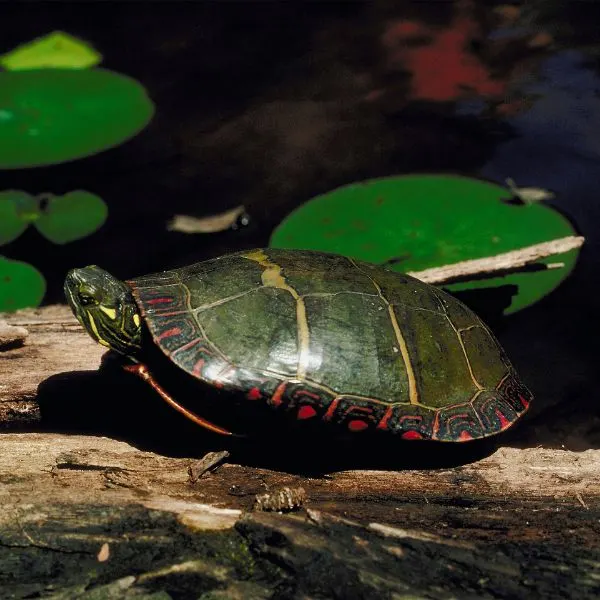
- Experience level: Beginner
- Family: Emydidae
- Scientific Name: Chrysemys picta
- Common Name: Painted Turtle
- Average Adult Size: 4 – 10 inches
- Life Span: 30 – 50 years
- Average Price Range: Between $30 to $150
- Conservation Status: Least Concern
Chances are you’ve seen Painted Turtles before because they are the most widespread turtle species in North America. The Eastern Painted turtle inhabits wetlands, ponds, streams, and more waterways from Nova Scotia all the way down to Louisiana. They prefer waters with a lot of vegetation they can swim through.
Painted turtles have smooth, flattened carapaces that range from olive to black. There is a red crescent or border on some of the marginal scutes while the fixed plastron is plain yellow.
Olive to black skin is complemented by yellow stripes that run along the head, neck, limbs, and tail.
Painted turtles are frequent baskets. Often you can see these large turtles crowding logs, rocky outcroppings, and banks. Whenever they feel threatened, they will quickly slide back into the water.
Young Paints are more carnivorous but will transition to more vegetation as they get older. Painted turtles will eat duckweed, water hyacinth, lily, and algae, as well as snails, fish, tadpoles, and insects.
18. Southern Painted Turtle

- Experience level: Beginner
- Family: Emydidae
- Scientific Name: Chrysemys dorsalis
- Other Names: Painted Turtle
- Average Adult Size: 4 – 6 inches
- Life Span: 20 – 25 years
- Average Price Range: $30 – $150
- Conservation Status: Least Concern
One of the main visual differences between Southern Painted turtles and the previously mentioned Eastern is the red stripe that runs through the middle of the carapace on the former. The second difference is the size.
Southern Painted turtles are almost half the size of full grown Eastern Paints. Otherwise, they look very similar with the smooth carapace, and stripes along their extremities.
These turtles prefer to live in slow moving waters and floodplains along larger rivers. Southern Painted turtles also spend a lot of time basking in the sun.
Like other Painted turtles subspecies, the Southern variety likes a well rounded diet. They will consume aquatic animals such as mollusks, insects, fish, and amphibians, as well as a wide variety of vegetation.
Pond Sliders in Louisiana
19. Red Eared Slider

- Experience level: Beginner
- Family: Emydidae
- Scientific Name: Trachemys scripta elegans
- Common Name: Pond slider, Red-eared terrapin, Water slider
- Average Adult Size: 6 – 8 inches
- Life Span: 20 to 40 years
- Average Price Range: approximately $30 to $100
- Conservation Status: Least concern
The Red Eared Slider is one of the most popular species of pet turtle on the market and has been for decades. They are highly adaptable, mostly aquatic, and will eat nearly anything.
Though they start off very small and cute, they quickly grow at least 8 inches long, and can sometimes surpass that size.
Though native to the Southeastern United States, populations of these turtles have been found in many other areas including countries in Europe and Asia.
Red Eared Sliders have smooth carapaces that start off green and highly patterned but will darken as they age. Basking in the sun helps to increase the dark coloration. They also have dark green, brown, or black skin with yellowish stripes.
Males have very long claws and longer tails than females. The big distinguishing characteristic is the red, oval-shaped marking behind their eyes that resembles ears.
Food is not a problem for these turtles as they will eat nearly anything that’s edible. From fish, crayfish, mollusks, insects, tadpoles, and an abundance of vegetation. Red Eared Sliders don’t usually have trouble finding food.
Snapping Turtles in Louisiana
20. Alligator Snapping Turtle

- Experience level: Expert
- Family: Chelydrida
- Scientific Name: Macrochelys temminckii
- Common Name: Loggerhead Snapper
- Average Adult Size: 13-30 inches
- Life Span: 30 – 50 years
- Average Price Range: Approximately $50 to $300
- Conservation Status: Threatened
Alligator Snapping turtles are instantly recognizable. If you watch many shows about nature and wildlife, you may have seen intrepid explorers reaching into muddy swamps to pull out gaping, huge-shelled monstrosities.
This is definitely not recommended as these turtles carry an extremely powerful bite. They can produce a bite force of nearly 1,000 pounds. That’s enough to sever fingers and break bones.
Alligator Snapping turtles have spiked shells, spiked tails, and spiked skin, though the tubercles on the skin are fleshy and not hard. When mud and algae are not covering their shells you may see olive green or dark brown coloration.
The plastron on these turtles is very minimal, usually white, and cross shaped. They have large, rounded limbs with thick, sharp claws.
When they reach adulthood, these turtles become very lethargic and don’t like to move much. They will very rarely bask, and typically they do this by swimming up to the surface of the water.
They are ambush hunters that use their modified tongues to attract prey. They use strong jaws and sharp beaks to crush prey that is too large to swallow whole. These turtles are carnivorous and will eat anything they can fit in their mouths.
21. Common Snapping Turtle

- Experience level: Intermediate to Expert
- Family: Chelydrida
- Scientific Name: Chelydra Serpentina
- Other Names: Snapping Turtle, Snapper, Eastern Snapping Turtle
- Average Adult Size: 8 to 20 inches
- Life Span: 30 – 50 years
- Average Price Range: Approximately $40 to $120
- Conservation Status: Least concern
Common Snappers are smaller than Alligator snappers, but still large, sometimes reaching up to 20 inches long and weighing 40 pounds on average. These turtles have smooth, thick carapaces with three ridges near the back.
Their skin ranges from yellow to brown, and they have a small light colored plastron. They have a very long neck, and strong, long limbs. Their tails are often half as long as their shell.
Snapping turtles are habitat generalists and will inhabit most types of water. While submerged, the Snapper is somewhat elusive and tends to swim away from threats. When they are on land, their attitude drastically changes.
They turn aggressive to anyone who approaches them and will hiss or bite if people get too close.
Their diet consists of fish, amphibians, insects, vegetation, and very rarely, waterfowl.
Softshell Turtles in Louisiana
22. Smooth Softshell Turtle
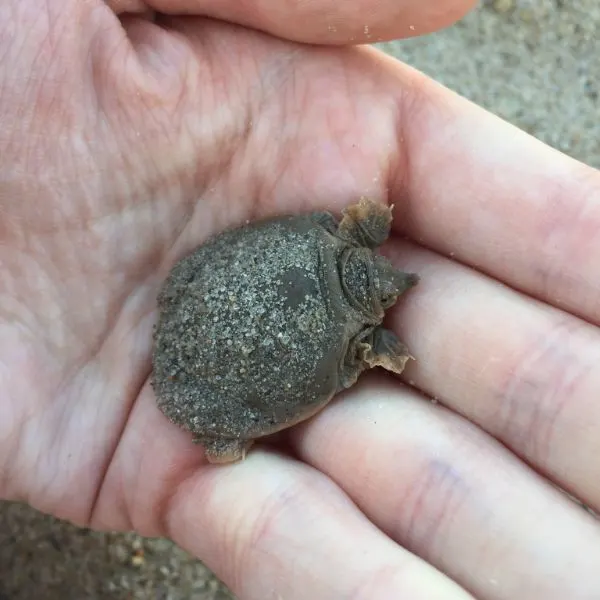
- Experience Level: Intermediate to Expert
- Family: Trionychidae
- Scientific Name: Apalone mutica
- Other Names: Spineless Softshell
- Adult Size: 4.5 to 14 inches
- Life Span: 25+ years
- Average Price Range: $40 to $60
- Conservation Status: Least concern
Smooth Softshell turtles are found in some northern areas of Louisiana. These odd looking turtles definitely resemble pancakes. They are brown to grey and very flat.
They don’t have a hard shell to protect themselves, so they developed speed, a sharp beak, and long, sharp claws for defense. These turtles are swift not only in the water but on land too.
Softshell turtles have long necks, and long, pointed snouts to help them reach the surface of the water without moving. They sometimes bury themselves in the sand or mud and wait for prey to come near.
Since they don’t have a hard shell, this turtle is able to use their skin to absorb oxygen from the water and stay motionless and submerged longer.
They are mostly carnivorous and will eat crayfish, mollusks, fish, tadpoles, and the occasional waterfowl. There have been reports of several softshell turtles ganging together to take down waterfowl.
When they hunt together the turtles use their sharp claws and beaks to tear pieces off the birds and eat them.
23. Spiny Softshell Turtle

- Experience Level: Intermediate to Expert
- Family: Trionychidae
- Scientific Name: Apalone spinifera
- Other Names: N/A
- Adult Size: 5 to 9 ½ inches for males, 10 to 20 inches for females
- Life Span: Between 20 and 50 years
- Average Price Range: Between $20 and $120
- Conservation Status: Threatened in some areas
Another pancake turtle, the Spiny Softshell sometimes has dark circles or spots on the flat, brown or grey, floppy carapace. They also have nubs and fleshy spikes on their shells.
These turtles prefer clear, shallow waters with soft or sandy bottoms. They don’t care for rocky or gravely bottoms or a lot of vegetation.
In most species of softshell turtles, the females are way bigger than the males. Sometimes females can grow 2 to 3 times as large as full-grown males of the same species.
Spiny Softshell turtles are mainly carnivorous. Crustaceans, invertebrates, mollusks, fish, tadpoles, frogs, and insects make up most of their diet. Occasionally, Spiny Softshells will nibble on aquatic plants.
Tortoises In Louisiana
24. Gopher Tortoise

- Experience level: Intermediate
- Family: Testudinidae
- Scientific Name: Gopherus Polyphemus
- Other Names: Gopher turtle, Florida Gopher tortoise
- Average Adult Size: 9 – 15 inches
- Life Span: 40 – 60 years
- Average Price Range: Illegal to sell, but may be adopted with special permits
- Conservation Status: Threatened
The Gopher Tortoise is the only native species of tortoise found in Louisiana, and it is a threatened species. They carry federal protection, so it’s illegal to take, harm, or possess these tortoises without a special permit.
You can apply for and adopt one from special tortoise rescue facilities if you are truly interested in owning one of these land dwelling turtles.
The Gopher tortoise, when born, is brightly colored, but it quickly fades. Adult tortoises are dull grey, brown, or tan with large, domed shells. They have thick, elephantine legs.
The front legs have large, thick claws, and serrated scales it uses for digging. These tortoises are a keystone species. This means they are beneficial to many other species, and if they go extinct, they will affect hundreds of other animals.
Gopher tortoises dig burrows that other animals use once it has abandoned them. These burrows can be up to 20 feet long, and it’s estimated that one tortoise will dig nearly 30 to 40 in a lifetime.
These tortoises prefer scrublands and dry prairies where the soil is easy to dig. They cannot swim and will only use puddles to soak and drink from.
Gopher tortoises are herbivores. They eat cacti, flowers, grasses, fruits, berries, and many other types of vegetation. Because of this, they are natural seed dispersers for many plants.
Sea Turtles In Louisiana
25. Atlantic Leatherback Sea Turtle

- Experience level: N/A, Illegal to own any sea turtle
- Family: Dermochelyidae
- Scientific Name: Dermochelys coriacea
- Other Names: Atlantic Leatherback, Leatherback
- Average Adult Size: 4 – 8 ft
- Life Span: 30 – 50 years
- Average Price Range: N/A
- Conservation Status: Endangered
The largest turtle in the world, Leatherback Sea turtles can grow to 7 or 8 feet long. They also don’t have a hard shell. Their back is covered in bony plates and a leathery skin.
Seven ridges converge to a point at the back of the turtle’s shell. Their skin is grey to black with white spots.
These turtles prefer deep ocean waters where they can feast on their favorite food, lion’s mane jellyfish.
While it’s rare, these turtles may be seen off the coast of Louisiana while they are migrating. These turtles travel thousands of miles yearly.
26. Green Sea Turtle

- Experience level: N/A, Illegal to own any sea turtle
- Family: Cheloniidae
- Scientific Name: Chelonia mydas
- Other Names: Green Sea Turtle
- Average Adult Size: 3 – 4 feet
- Life Span: 50 – 70 years
- Average Price Range: N/A
- Conservation Status: Endangered
Green Sea turtles stay near busy reefs so they can feed on algae and sea grasses. This is what gives them their name. Green Sea turtles are many colors, mostly white, cream, and brown.
Their flesh and fat are green because of their diet, and that is where their name comes from.
All sea turtles are endangered and it’s illegal to own or even touch any sea turtle. Their numbers are in decline because of fishing nets, boating accidents, hunting, and harvesting of their eggs.
27. Loggerhead Sea Turtle

- Experience Level: N/A, Illegal to own any sea turtle
- Family: Cheloniidae
- Scientific Name: Caretta Caretta
- Other Names: Loggerhead
- Adult Size: 2.5 – 3.5 feet
- Life Span: 70 – 80 years
- Average Price Range: N/A
- Conservation Status: Endangered
The Loggerhead Sea turtle is named because of the huge head and jaw muscles they have. These characteristics help them to crack open their favorite foods. These turtles eat conch, whelk, crustaceans, and horseshoe crabs.
To crack through these tough shells, the Loggerhead needs powerful muscles and a blunt beak.
Loggerhead turtles have recently begun nesting on Louisiana’s shores once again after being absent for decades. They begin nesting in April and continue on until September. Females will lay 3 to 5 nests in a season, then take a year or two off before nesting again.
28. Kemp’s Ridley Sea Turtle

- Experience level: N/A, Illegal to own any sea turtle
- Family: Cheloniidae
- Scientific Name: Lepidochelys kempii
- Other Names: Atlantic Ridley, Tortuga Lora (Mexico)
- Average Adult Size: 24 – 27 inches
- Life Span: 30 years
- Average Price Range: N/A
- Conservation Status: Critically endangered
The smallest of all the sea turtles and the most critically endangered, the Kemp’s Ridley Sea turtle grows just over 2 feet long.
Their population reached critically low numbers in the 1980s, but have since started coming back. Thanks to the efforts of scientists, turtle lovers, and enthusiasts these turtles are experiencing a comeback. Unfortunately, they still are nowhere near the numbers they should be.
The Kemp’s Ridley Sea turtle has a triangular head and a slight beak. They have a greyish green carapace and pale yellow bottom. Their front flippers have a single, short claw on them, while the back flippers may have up to 2 each.
Kemp’s Ridley Sea turtles eat crustaceans and crabs but may feed on discarded crabs and bycatch.
Recently, small populations of these tiny sea turtles have started nesting on Louisiana beaches too. If you’re lucky, maybe you could see them during this amazing process!
29. Hawksbill Sea Turtle
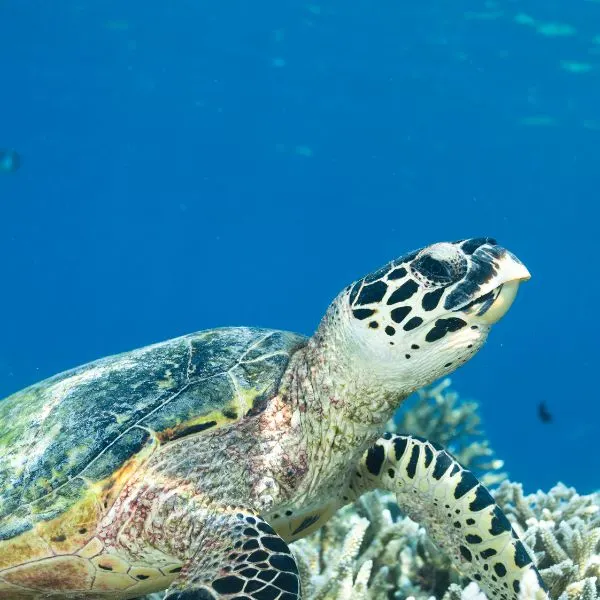
- Experience level: N/A, Illegal to own any sea turtle
- Family: Cheloniidae
- Scientific Name: Eretmochelys imbricata
- Other Names: Hawksbill
- Average Adult Size: 30 – 36 inches
- Life Span: 50 – 60 years
- Average Price Range: N/A
- Conservation Status: Critically endangered
The Hawksbill Sea turtle has a sharp, curved beak that resembles the bird of prey. These turtles are often described as the most beautiful of all the sea turtles. Unfortunately for them, this beauty makes them a target for illegal poachers.
Hawksbill turtle shells are marbled with brown, green, yellow, and black colors. Hunters take these shells and turn them into frivolous trinkets such as glasses rims, hair accessories, lamps, and other such items.
Whenever you see items made of tortoiseshell, it most likely came from a Hawksbill Sea turtle.
These turtles are protected in American waters, but that doesn’t stop poachers from taking them.
Sponges are this turtle’s favorite food. They swim around tropical waters to feed on this food source.
FAQs
What turtles live in Louisiana swamps?
Many turtles may be found in the swamps in Louisiana. Most notable are Common and Alligator Snapping turtles. You may also find mud, musk, and even some softshell varieties.
Can you eat turtles in Louisiana?
You don’t have to be in Louisiana to eat turtles. As long as you follow proper hunting laws you can hunt and eat turtles in most states across the U.S. There are some restaurants in Louisiana that still serve turtle dishes. Most are found in New Orleans and other southern cities.
Can you hunt turtles in Louisiana?
As long as you follow proper rules you can hunt turtles in Louisiana. You can hunt both species of Snapping turtles and Softshell turtles, but be sure to check out Louisiana’s Hunting regulations before doing so.
Wrapping up
There we have it. An exhaustive list of all the turtles you may find in and around Louisiana. The Sportsman’s Paradise has a wide variety of reptiles you may come across while on your travels.
You may see small Diamondback Terrapins, medium sized Red Eared Sliders, or large Softshell or Snapping turtles in the waters around the state. If you’re truly lucky you might be able to spot nesting sea turtles along some of the sandy beaches.
If you’re a turtle enthusiast, and you must be if you reached the end of this big list, leave us a comment. We love hearing from our readers.
Other nearby states
